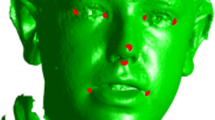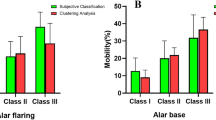Abstract
With the development of 3D printing and computer graphics technology, mouth rehabilitation has increasingly adopted digital methods. This research proposes a new method to transform the appearance of facial model after complete denture prosthesis. A feature template with few feature points is first constructed according to the facial muscle anatomy and facial deformation after complete denture prosthesis. Next, the traditional as-rigid-as-possible (ARAP) method is optimised by clustering based on facial muscles. The optimised ARAP method is then used for real-time and interactive simulations. Finally, by classifying the degrees of elasticity in the model with additional weights, the simulation can be customised to the skin of individual patients. Different degrees of elastic deformation and post-operative models are superimposed for match analysis. Compared with our previous study, the error is reduced by 24.05%. Results show that our method can deform facial models accurately and efficiently.
















Similar content being viewed by others
References
Baran I, Popovic J (2007) Automatic rigging and animation of 3D characters. ACM Trans Graph 26(3):72
Botsch M, Sorkine O (2008) On linear variational surface deformation methods. IEEE Trans Visual Comput Graph 14(1):213–230
Chabanas M, Luboz V, Payan Y (2003) Patient specific finite element model of the face soft tissues for computer-assisted maxillofacial surgery. Med Image Anal 7(2):131–151
Chao I, Pinkall U, Sanan P, Schroder P (2010) A simple geometric model for elastic deformations. ACM Trans Graph 29(4):157–166
Cheng C, Cheng X, Dai N, Jiang X, Sun Y, Li W (2015) Prediction of facial deformation after complete denture prosthesis using BP neural network. Comput Biol Med 66:103–112
Cotin S, Delingette H, Ayache N (1999) Real-time elastic deformations of soft tissues for surgery simulation. IEEE Trans Visual Comput Graph 5(1):62–73
Courtecuisse H, Jung H, Allard J et al (2010) GPU-based real-time soft tissue deformation with cutting and haptic feedback. Prog Biophys Mol Biol 103(103):159–168
Gladilin E (2003) Biomechanical modeling of soft tissue and facial expressions for craniofacial surgery planning. Dissertation
Igarashi T, Moscovich T, Hughes JF (2005) As-rigid-as-possible shape manipulation. ACM Trans Graph 24(3):1134–1141
Joldes GR, Wittek A, Miller K (2009) Suite of finite element algorithms for accurate computation of soft tissue deformation for surgical simulation. Med Image Anal 13(6):912–919
Joshi P, Meyer M, Derose T, Green B, Sanocki T (2007) Harmonic coordinates for character articulation. ACM Trans Graph 26(3):71
Ju T, Schaefer S, Warren J (2005) Mean value coordinates for closed triangular meshes. ACM Trans Graph 24(3):561–566
Keeve E, Girod S, Kikinis R, Girod B (1998) Deformable modeling of facial tissue for craniofacial surgery simulation. Comput Aided Surg 3(5):228–238
Koch RM, Gross MH, Carls FR, Von Buren DF (1999) Simulating facial surgery using finite element models. In: Proceedings of ACM SIGGRAPH, pp 421–428
Lewis JP, Cordner M, Fong N (2000) Pose space deformations: a unified approach to shape interpolation and skeleton-driven deformation. Conf Comput Graph Interact Tech 6:165–172
Lipman Y, Levin D, Cohenor D (2008) Green coordinates. Acm Trans Graph 27(3):15–19
Liu L, Zhang L, Xu Y, Gotsman C, Gortler SJ (2008) A local/global approach to mesh parameterization. Comput Graph Forum 27(5):1495–1504
Lu MH, Zheng YP (2004) Indentation test of soft tissues with curved substrates: a finite element study. Med Biol Eng Comput 42(4):535–540
Maccracken R, Joy KI (1996) Free-form deformations with lattices of arbitrary topology. Conference on computer graphics & interactive techniques, pp 181–188
Niroomandi S, Alfaro I, Cueto E et al (2012) Accounting for large deformations in real-time simulations of soft tissues based on reduced-order models. Comput Methods Programs Biomed 105(1):1–12
Sarti A, Gori R, Lamberti C (1999) A physically based model to simulate maxillo-facial surgery from 3D CT images. Future Gener Comput Syst 15:217–222
Takács Árpád, Rudas IJ, Haidegger T (2015) Surface deformation and reaction force estimation of liver tissue based on a novel nonlinear mass–spring–damper viscoelastic model. Med Biol Eng Comput 48:361–370
Teschner M, Girod S, Girod B (2000) Direct computation of nonlinear soft-tissue deformation. Vision, modeling, visualization, VMV, pp 383–390
Wareham R, Lasenby J (2008) Bone glow: an improved method for the assignment of weights for mesh deformation. Articulated motion & deformable objects, international conference, pp 63–71
Weber O, Benchen M, Gotsman C (2009) Complex barycentric coordinates with applications to planar shape deformation. Comput Graph Forum 28(2):587–597
Weichert F, Schröder A, Landes C, Shamaa A, Awad SK, Walczak L, Müller H, Wagner M (2010) Computation of a finite element-conformal tetrahedral mesh approximation for simulated soft tissue deformation using a deformable surface model. Med Biol Eng Comput 48(6):597–610
Zachow S, Gladiline E, Hege H, Deuflhard P (2000) Finite-element simulation of soft tissue deformation. Computer assisted radiology and surgery (CARS), Elsevier Science BV, pp 23–28
Acknowledgements
This study was supported by the National Natural Science Foundation of China (51205192, 81271181), Jiangsu Key Technology Support Program (No. BE2014009-3), the Natural Science Foundation of Jiangsu Province, China (No. BK20161487) and Six talent peaks project in Jiangsu Province, China (No. GDZB-034).
Author information
Authors and Affiliations
Corresponding authors
Ethics declarations
Conflict of interest
The authors declare that there is no conflict of interests regarding the publication of this paper.
Rights and permissions
About this article
Cite this article
Cheng, C., Cheng, X., Dai, N. et al. Deformation of facial model for complete denture prosthesis using ARAP group method and elastic properties. Med Biol Eng Comput 55, 1635–1647 (2017). https://doi.org/10.1007/s11517-017-1626-x
Received:
Accepted:
Published:
Issue Date:
DOI: https://doi.org/10.1007/s11517-017-1626-x




